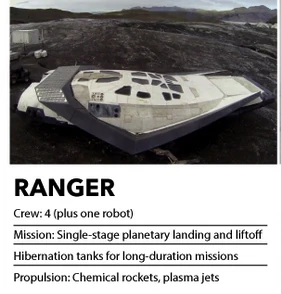
The Ranger is a single-stage-to-orbit (SSTO) reconnaissance spacecraft built and used by NASA. Two Rangers were part of the Endurance mission, named Ranger 1 and Ranger 2. Twelve additional Rangers were also builand launched for the Lazarus missions ten years prior.
History[]
The Ranger program began decades ago to produce a viable, reusable, high-efficiency SSTO craft that could climb out of the Earth's gravity well single-handed, achieve orbit, then de-orbit to land on the planet's surface. Or, vice-versa, the Ranger could de-orbit around a terrestrial world, land safely, and lift-off again to orbit.
Joseph Cooper was a test pilot in the Ranger program prior to the apparent dissolution of NASA several years ago.
Design[]
The Ranger is designed along the lines of a lifting body, but is equipped with small, canted wings for additional lift and stability.
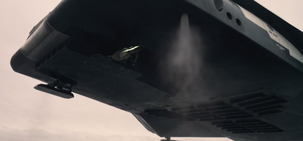
Ranger 1 landing on Miller's planet
Unlike its distant predecessor, the Space Shuttle, the Ranger uses a novel aerodynamic control system that relies on reaction control system (RCS) thrusters and electrically powered air jets to provide pitch, yaw, and roll control. This effectively eliminates a variety of moving parts such as flaps, ailerons, elevators, and rudders which would otherwise increase weight and mechanical complexity.
While lacking traditional flight control surfaces, the Ranger is completely reliant on its electric air jets and is incapable of unpowered gliding. If the flight control system experiences a total loss of power, the Ranger would spiral out of control and fall from the sky, requiring its pilot and its passengers, to eject. Such an event is unlikely due to the installation of multiple redundant power sources and a negotiable flight computer, creating a more rugged and reliable spacecraft. Power is provided by twin miniaturized tokamak fusion reactors, a triple redundant fuel cell system, and high efficiency solar cells on its roof. :)
The electric air jets also enables the Ranger to propel itself through a planetary atmosphere. High powered fans draw air from slot-like intakes near the nose and on the corners of the wing structure. Incoming air is accelerated and channeled through the trailing edges of the wings and through vents on its underbelly; which are covered by opening and closing louvers. Depending on the louver angle, airflow can be diverted, or vectored downward for precise vertical-takeoff-and-landing (VTOL) or rearward for forward flight. The Ranger is controlled by a fly-by-wire system.
After a de-orbit burn, the Ranger's broad underbelly heat shield is used to shed most of its velocity against a planetary atmosphere. Once near the surface at lower speeds, its ventral thrusters and air jets are used to softly land on a planet's surface. Simple landing struts are deployed to keep the heat shield tiles from touching the ground. The Ranger is also designed to float in the event of a water landing.
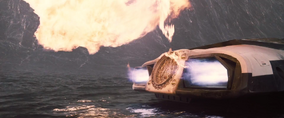
Ranger 1 ignites its twin plasma engines
The Ranger's main propulsion system are twin linear aerospike hybrid plasma engines - a marriage of two different rocket engine technologies capable of achieving high thrust while greatly reducing fuel consumption. Chemical rocket engine exhaust is ionized into plasma and magnetically accelerated to very high velocities, vastly increasing fuel efficiency. This enables the Ranger to achieve orbit, accelerate to escape velocity, and travel to other planets, requiring little to no rocket staging. If available, local atmospheric oxygen is collected and burned during atmospheric flight, saving its internal oxygen supply for very high altitudes and orbital maneuvering.
The Ranger's cabin/cockpit is capable of maintaining a pressurized Earth-like atmosphere. It is composed of two compartments; the forward section is a cockpit that includes four ejectable crew seats and two folding benches for four additional passengers. The cockpit also contains four hibernation tanks and contingency supplies for long duration missions. The aft compartment functions as an airlock. Inside the airlock are two ports (one aft and one on the floor) that can dock with other spacecraft. The aft docking port can lower down to serve as a gangplank to the surface when landed.
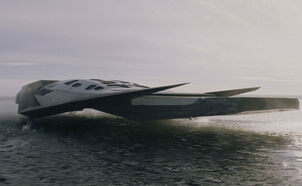
Ranger 1 on Miller's planet
When necessary, the Ranger can be connected to a second Ranger in a double belly-to-belly configuration on the Endurance, launched on a multistage rocket, configuration to conserve fuel, or with a Lazarus pod for a one-way mission to a potentially habitable planet. A Ranger carrying a heavy Lazarus pod, despite its efficient engines, would likely exhaust its fuel in order to reach Saturn, cross the wormhole, and maneuver through a foreign planetary-system to reach its final destination. With no fuel available to return to Earth, it is left in orbit while the Lazarus pod descends to the surface.
Next Generation Rangers[]
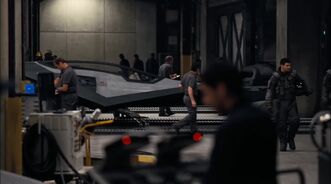
Future 22nd Century Ranger spacecraft being prepared on Cooper Station.
By the 22nd Century, when mankind had left Earth entirely, newer generations of Rangers were built and flown. These were much smaller than their 21st-Century predecessors, about the size of a family sedan. The cockpit had only enough room for one pilot in front and a support robot, laying back over several folded passenger seats. Despite their size, it is shown to have significant range, as regular patrols were launched from stations in orbit throughout the Solar System. It was implied the new Rangers had enough power to travel to distant planets. In the official novelization, Cooper wondered if the new Rangers used a miniaturized version of Murph's gravity drive.
Cooper Station sported an entire fleet of these next-generation rangers. At least two were on the scene to recover both Joseph Cooper and TARS. Later on, Cooper and TARS stole one of the mini-Rangers from the hangar to cross back through the wormhole to find Amelia Brand on Edmunds' planet. While the spacesuit of the Lazarus astronauts were orange and white and the spacesuits of the Endurance astronauts were blue and white, the Cooper Station spacesuits were almost entirely black.
Known Ranger Spacecraft[]
- Ranger test ship - Piloted by Joseph Cooper at the outset of the film.
- Ranger 1 and Ranger 2 - Shuttles attached to the Endurance.
- 22nd-Century Rangers - Smaller variants used for patrol and search-and-rescue.